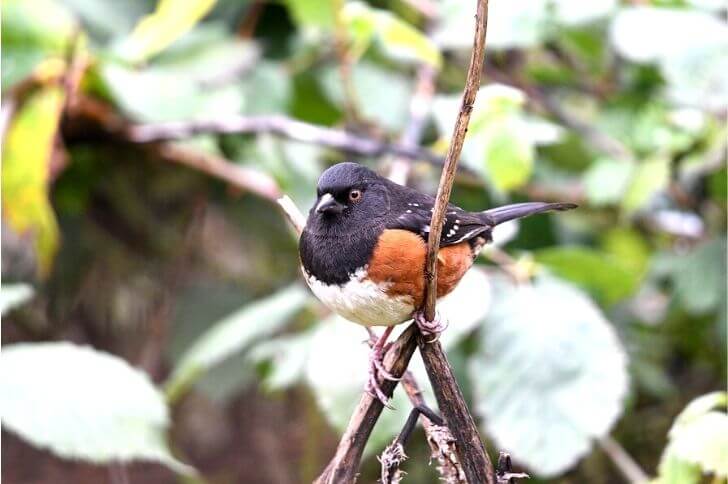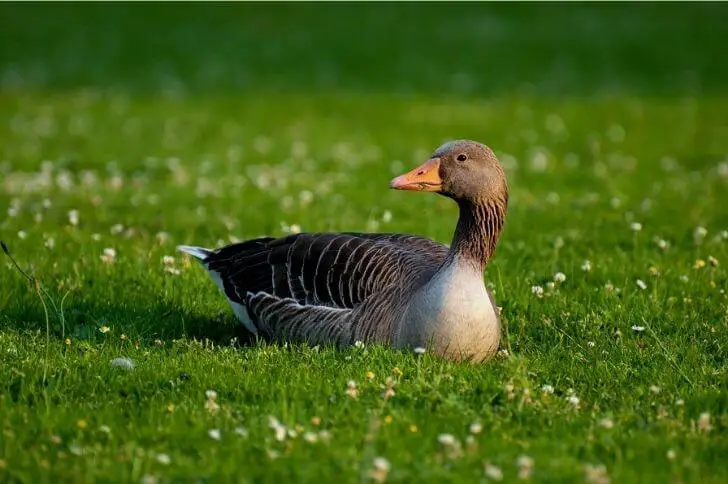Birds are a vital part of the ecosystem of Long Island. They help to control insect populations, disperse seeds, and pollinate plants. Birds also play an important role in the lives of humans, providing us with enjoyment and inspiration.
There are over 200 species of birds that have been documented on Long Island. The island is home to both migratory and resident birds. Migratory birds use Long Island as a stopover point during their journey between breeding and wintering grounds.
Below we’ll look at various birds of long island including blue jays, northern flickers, dark eyed juncos, white throated sparrows and the northern cardinal. We’ll look at their habitats, breeding habits, and more.
List of Birds in Long Island
1. White-Throated Sparrow
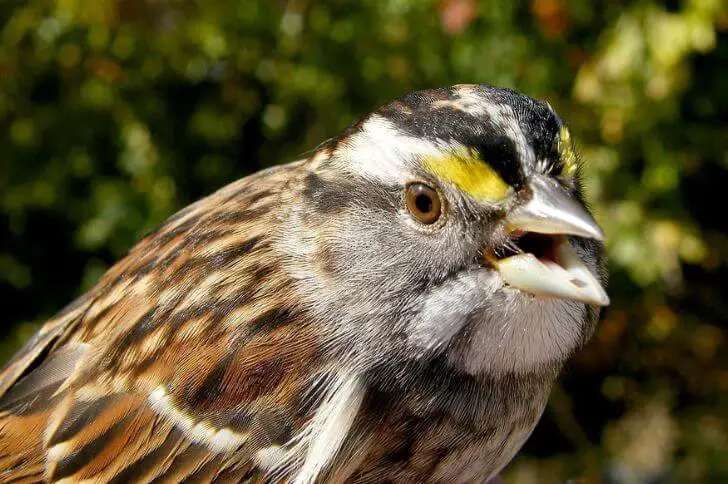
White-throated sparrows can be found throughout Long Island. They belong to the family passalidae.
Identification:
With a long tail, this plump bird in Long Island has distinctive plumage. The bird has a striped black and white head, white throat, gray breast and face, and brown and streaked upperparts. Notice the yellow spot next to its eyes.
An adult bird is 6.3-7.1 inches long with a span of up to 9.1 inches.
Other facts:
The bird is known for its distinctive song, which consists of two phrases. The first phrase is “oh sweet Canada, Canada, Canada.” The second phrase is “Old-sam-peabody.” The song is often heard in the springtime.
The white-throated sparrow is a common bird, and can be found in many different habitats. However, the bird prefers to nest in areas with dense vegetation. The bird’s diet consists mainly of insects and seeds.
2. Pileated Woodpecker
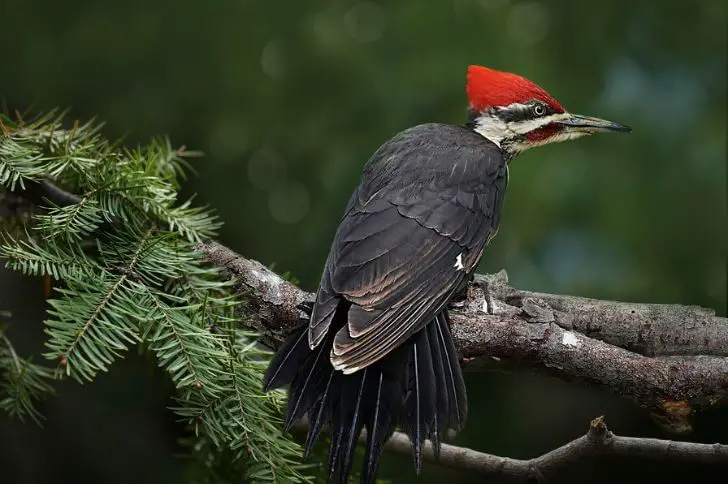
Pileated woodpeckers are one of the largest and most distinctive woodpeckers in Long Island. What is another name for this unique bird? Pileated woodpeckers are also known as wood hens.
Identification
Measuring up to 19 inches in length, this bird is one of the largest woodpeckers of Long Island. When you go bird watching, you can easily identify it by its black and white plumage.
The adult pileated woodpecker is black above and below with a white stripe on its face that continues down its neck to the side. To tell the sexes apart, males have a red stripe on the cheeks while females do not. Both sexes have a flaming red crest.
Other Facts:
They are known for their loud, drum-like call and their habit of scaling trees in search of insects. Pileated woodpeckers prefer mature woods with large trees, but can also be found in younger forests and even suburban areas. These birds play an important role in forest ecology by excavating cavities that provide homes for other wildlife.
Despite their large size, pileated woodpeckers are agile fliers and excellent climbers. Their long tongue is specially adapted for reaching deep into crevices to capture insects.
3. Blue Jays

Another group of birds in Long Island that you like to see in your backyard are the blue jays. The blue jay is a member of the crow family. It is native to North America and can be found in wooded areas.
Identification:
The blue jay is known for its beautiful blue plumage. An adult has blue upperparts and white below. The wings are also blue with white bold wingbars. Notice the black collar around its neck.
Interesting facts:
Can you attract these common backyard birds? These New York birds prefer hopper bird feeders. You can attract blue jays to your yard using sunflower seeds and peanuts.
The blue jay is a very intelligent bird. It has been known to mimic the calls of hawks. It is a very playful bird. It often engages in acrobatics, such as flipping over in mid-air. The blue jay is also known to play hide-and-seek with other birds.
Breeding season normally lasts for 5 months, March-July, where the female lays 5-7 bluish eggs.
Also read: Birds of Kauai Island
4. Northern Flicker

One of the most beautiful birds of Long Island is the Northern Flicker. These birds are very unique in their appearance, and they are also very interesting creatures. Here are some facts about the Northern flicker that you may not know.
Identification:
The Northern flicker is a member of the woodpecker family. These birds are very distinctive in their appearance. They are slightly smaller than the pileated woodpecker, about 12 inches long with a wingspan of up to 20 inches.
They come with two distinctive colors. Adults have spotted bellies, black chest band, brown-pink throat, black whiskers, olive-green spotted back, a gray cap and yellow shaft.
The second adult morph is a gray spotted belly, gray chest and head, red whiskers, and grayish brown back. These birds have a red shaft.
Other Facts:
These birds are very vocal, and they are known for their loud “wick-a-wick-a” call. The Northern flicker is also known as the common flicker or yellowhammer or gawker bird.
Northern flickers eat mainly ants and beetles, but they will also eat other insects, fruits, and berries.
Their breeding season starts from March to June, laying up to 8 eggs and nesting for up to 27 days. Northern flickers babies are naked and clumsy.
5. Rosy-faced Lovebird

Rosy-faced lovebirds are one of the most popular pet birds in the world. If you are looking for a pet that’s great company, consider this unique bird.
Identification:
This medium size bird is endemic to parts of Africa and has been introduced to other parts of the world as pets. In some parts of the United States, people release them to the wild and you can find them in large numbers in Arizona and other states.
How can you identify rosy-faced lovebirds? They are 7 inches long and green overall with blue rump. Their throat and face are pink while their bills are white.
Other facts:
Rosy-faced lovebirds make great pets because they are very affectionate and playful. They are also relatively easy to care for, although they do require a bit more attention than some other bird species.
If you’re looking for a fun and loving companion, a rosy-faced lovebird may be the perfect pet for you!
6. Eastern Screech Owl
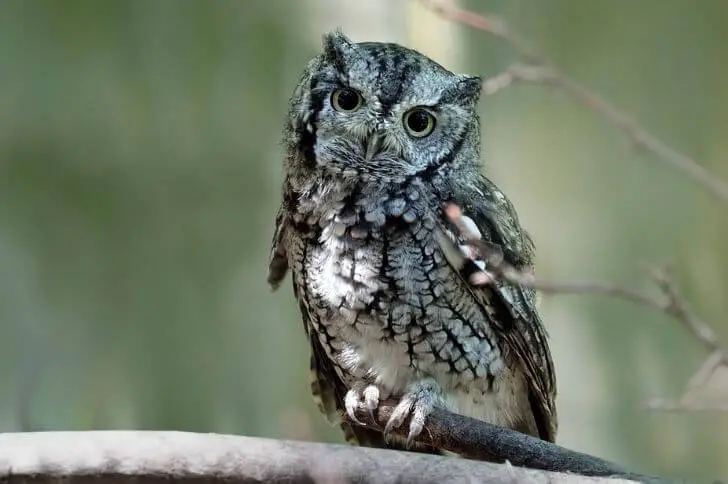
Another bird that you can find in Long Island in New York is the Eastern screech owl. These owls are nocturnal.
Identification:
Like other birds in their family, these birds spot striking yellow eyes and sharp talons. Adults have two morphs. They are either gray with black vertical stripes or reddish-brown with vertical streaks. They also have some white patches.
Other facts:
They have distinctive calls that help them to communicate with each other. Eastern screech owls are able to adapt to different habitats and can be found in forests, fields, and even urban areas.
From Cold Spring Harbor to Butler Huntington Woods, there are plenty of places you can find this bird of Long Island. During nesting season, these birds lay up to 6 eggs that are incubated for up to 34 days.
They mostly feed on mammals as well as small birds.
7. Great Horned Owl

Another type of owl of Long Island is the Great Horned Owl. How big is this New York Bird?
Identification:
Adult great horned owls are about 18-24.8 inches long and a wingspan of 39-57.1 inches. They are slightly larger than the American crow.
They are gray with black spots, bright yellow eyes, and large ear tufts.
Interesting facts:
The Great horned owl is a large bird of prey found in Long Island. It is one of the most common owl species in North America, and its distinctive hooting call is often heard at night.
These Long Island birds are powerful hunters, preying on small mammals and birds. They have piercing yellow eyes and large ear tufts that give it a fierce appearance. These owls are found in many different habitats, from forests to grasslands.
8. Black and White Warbler

Black and White Warbler –Mniotilta varia
Small and striped, the black and white warbler is a beautiful bird that is easily recognizable. These birds are found in wooded areas across New York State and are a common sight at bird feeders.
Identification:
Black and white warblers are winter visitors on tube feeders. Be on the lookout for a small black and white striped bird. Females have grayish ear patches while males have a black ear patch. They have a wingspan of up to 8.7 inches, about the size of a house sparrow.
Other facts:
Although they are small birds, they are powerful songsters with a distinctive warbling call. Black and white warblers are non-migratory birds, which means they spend their entire lives in the same general area.
These little birds play an important role in the ecosystem by eating insects that would otherwise damage trees and plants. They also help spread seeds as they travel from place to place in search of food. Black and white warblers are not currently considered to be at risk of extinction, but like all bird species, they may be affected by habitat loss in the future.
9. Northern Cardinals
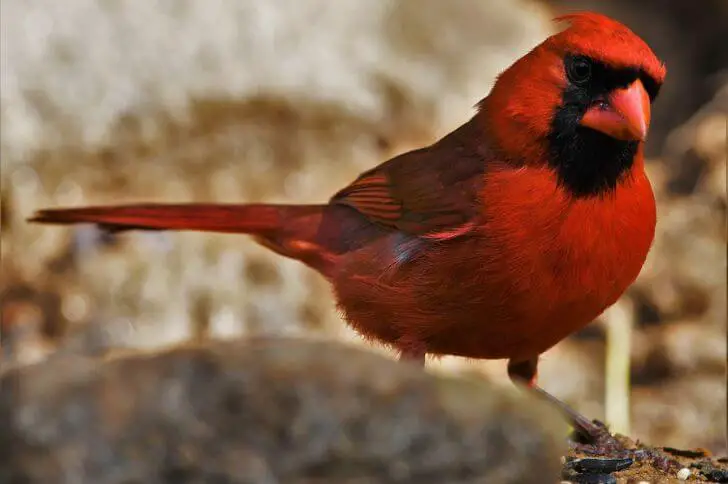
Another type of winter birds on Long island are the Northern Cardinals. This common backyard bird is not only common but a favorite among bird watchers.
Identification:
Males and females have a similar build but different plumage. The male of this bird species is a bright red with a beautiful black face while the female is a brown, with a red crest, wing feathers, and bill. Both sexes have long tails.
Other facts:
Can you attract birds of this species to your yard? Absolutely. Northern cardinals frequent backyard feeders with sunflower seeds. These birds in Long Island can live up to 15 years.
Related Read: Check Maui Birds
10. Barn Owl

The barn owl is a bird of prey that can be found in many parts of New York State. These nocturnal predators are known for their distinctive call and their eerie hunting habits. Although they are sometimes considered to be pests, barn owls play an important role in the ecosystem.
Identification:
Barn owls are medium-sized birds with long legs and a round head. They have a white face with black eyes and a dark brown or gray body. The female barn owl is usually larger than the male.
Other facts:
Barn owls hunt at night, using their sharp vision and hearing to locate their prey. They will often perch on a branch or post, waiting for an animal to move below them. When they spot their target, they will swoop down and snatch it up with their talons.
11. Red-Bellied Woodpeckers

Red bellied woodpeckers are a species of woodpecker that is native to North America. These birds are usually found in forests and woodlands, and they get their name from their reddish-brown belly.
Identification:
Like other birds in their family, these birds have black and white plumage. Backs are spotted black and white and white below. The red nape and crown on the males will help you differentiate them from the females.
Other Facts:
Red-bellied Woodpeckers are known for their ability to peck holes in trees, which they use for nesting and foraging. Red bellied woodpeckers typically nest in cavities that they excavate themselves. These birds mainly eat insects, but they will also eat fruits and nuts.
Red bellied woodpeckers are relatively small birds, with a length of about 9 inches.
12. House Sparrows

A member of the sparrow family, the house sparrow is one of the most common birds in Long Island. Originally from Europe, Asia and North Africa, these little birds have adapted to almost every environment imaginable.
Identification:
Breeding male have distinctive plumage. They are dark-brown and streaked above with a brown nape and gray crown. They have white cheeks and dark throats.
In contrast, females have brown-gray underparts, and dull streaked upperparts. Both sexes have short black bibs.
Other facts:
While they are not particularly beautiful birds, their chirping can be quite pleasant. Unfortunately, house sparrows can also be a nuisance. They are known to build their nests in gutters, eaves and other places where they can cause damage.
Despite their potential problems, many people appreciate house sparrows for their cheerful dispositions and willingness to live near humans. These hardy little birds are here to stay and will likely continue to bring enjoyment – and occasional frustration – to those who share their space.
13. Snow Goose
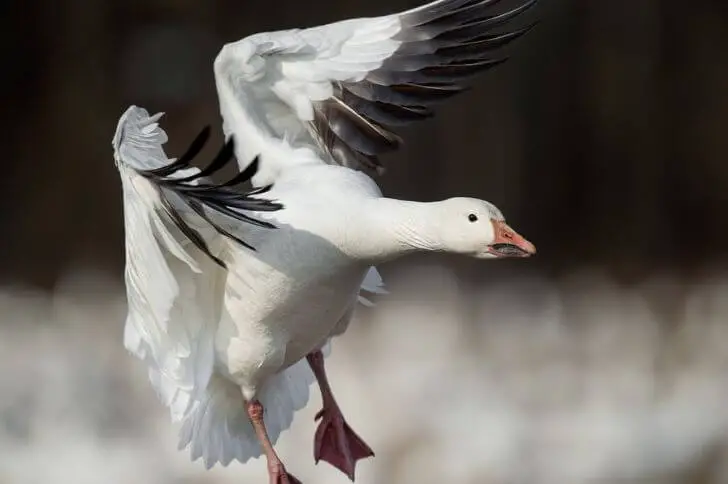
Very loud and distinctive, the snow goose is a waterbird of Long Island. These geese are unique in both their appearance and their behavior.
Identification:
Like owls of Long Island, snow geese have two different morphs. Snow geese can be white with black tail or black with a white head. They also have thick, pink bills and feet.
Other facts:
They have a honking call that is distinct from other types of geese. They are also different in that they often travel in huge flocks, sometimes numbering in the thousands.
These flocks can be a nuisance to farmers whose fields they descend upon, but they can also be a beautiful sight. Snow geese mate for life and return to the same nesting grounds year after year. Watching them fly overhead is a sure sign that winter is on its way.
14. European Starling
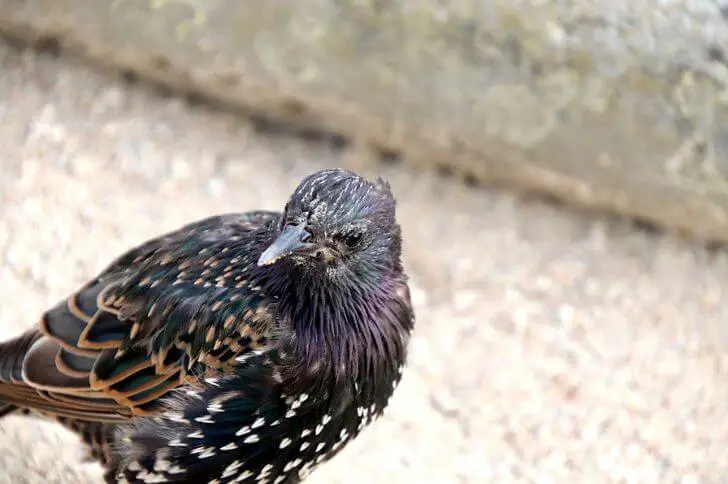
Did you know that the European starling was not originally from Europe? This invasive species was introduced to North America in the 1890s by a group of Shakespeare enthusiasts who wanted every bird mentioned in the Bard’s works to have a home in the New World.
Today, there are an estimated 200 million European starlings in the continental U.S and Long Island is no exception.
Identification:
These Long Island birds are 7.9-9.0 inches long. They are chunky, dark overall with greenish-purple iridescent. They also have beautiful yellow bills. Immature birds are brighter with a dark bill.
Other facts:
These voracious eaters consume up to two-thirds of their body weight each day, and their diet consists mostly of reptiles, insects, and snails. These black birds of Long Island are considered a nuisance. In addition to being a nuisance, European starlings are also known carriers of diseases like salmonella and avian flu.
15. Gray Catbird

Also known as the sloted-colored mockingbird, the gray catbird is a bird that is known for its cat-like sounds. These birds are found in North and South America, and their diet consists mainly of insects.
Identification:
Catbirds are relatively small birds, with adults measuring anywhere from 9 to 11 inches in length. They have gray, black caps, and brown feathers undertail coverts. Their tails are long and pointed.
The males and females of this species look very similar, although the males tend to be slightly larger than the females.
Other Facts:
Although they are not typically considered to be friendly birds, catbirds can actually make good pets if they are raised from a young age. They are relatively easy to care for, and they can provide their owners with hours of entertainment by imitating the sounds of other animals.
16. Red-winged Blackbirds
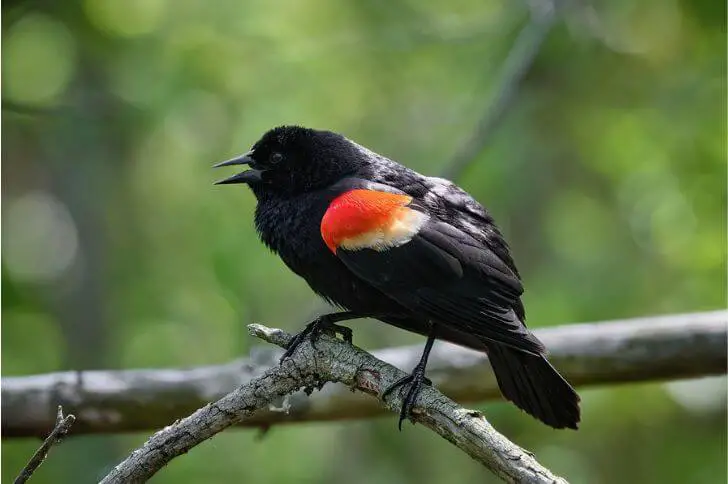
Red-winged blackbirds are one of the most common and widespread birds in Long Island, New York. They are found in nearly every habitat, from open fields and wetlands to urban parks and backyards. These adaptable birds have even been known to nest in abandoned buildings!
Identification:
Red-winged blackbirds are easily recognized by their distinctive plumage. The males have bright red shoulders and wings, with a black body. The females are mostly brownish-black, with dark streaks. Males have a yellow bar on their wing while females have a yellowish mandible.
Other facts:
These vocal birds are often heard before they are seen. The males sing a loud, musical song consisting of several clicks, chirps, and whistles. The females make a softer “tchew” sound.
They lay blue-green eggs that take two weeks to hatch. Juvenile red-winged blackbirds stay in the nest for two weeks. The oldest known red-winged blackbird lived for 15 years.
17. House Wren
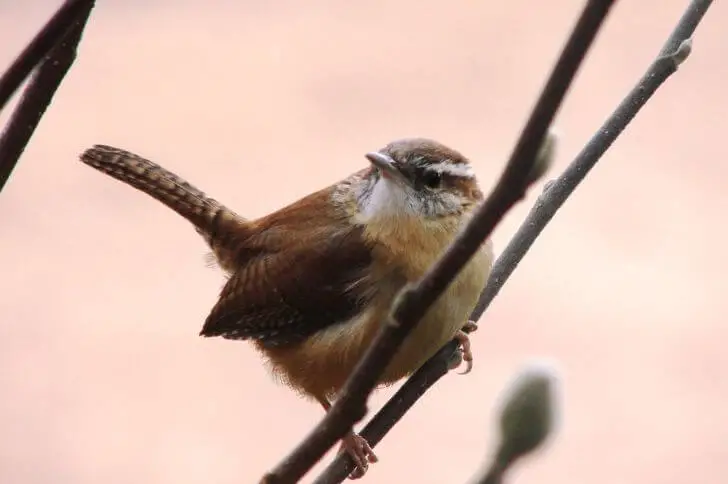
With their breeding season lasting through spring and summer months, house wrens are small common backyard birds of Long Island.
Identification:
House wrens are brown in color with dark wingbars, and they have a long tail that is often held upright. They are about the same size as the chickadee, 4.-5.1 inches long and a span of 5.9 inches.
Other facts:
These birds are known for their loud and cheerful songs, which they often sing while perched atop a fence post or tree branch. They build their nests in cavities, such as holes in trees or nest boxes. House wrens are insectivores, and they use their long beaks to pluck insects from the ground or foliage.
18. Eastern Wood-Pewee

A member of the tyrant flycatcher families, the Eastern wood-pewee is a medium-sized bird that is found in the eastern United States.
Identification:
The bird has a dark gray body with a white breast and belly. The wings are black with white bars. The tail is black with a white tip. The bill is black, and the legs are gray. The bird breeds in deciduous forests and winters in the southern United States.
Interesting facts:
The Eastern wood-pewee is found in the eastern United States from New York to Florida. During their nesting season, a pair will weave a 3-inch nest using weeds, mosses, roots, pine needles and other materials.
Females will then lay 2-4 creamy speckled eggs that are incubated for two weeks. Baby eastern wood-pewee have downy feathers.
19. Rock Pigeon

Pigeons are favorite birds among birding enthusiasts. The rock pigeon is a species of bird that is found in many parts of the world and is a member of the family Columbidae, which includes doves. It is also a member of the genus Columba.
Identification:
Rock pigeons are medium-sized birds with blue-gray heads, gray on their backs and wings, and belly. They have an iridescent collar around their neck and black bands on their tail feathers.
Rock pigeons have yellow eyes and a dark beak. Male and female rock pigeons look similar, but females tend to be slightly smaller than males.
Other Facts:
Rock pigeons are social birds that live in flocks of up to 100 individuals.
20. Downy Woodpeckers

One of New York’s smallest woodpeckers is the downy woodpecker.
Identification:
Measuring about 6-7 inches in length, the adult downy woodpecker has a black back with white stripes running down to its tail. Its belly is also white and its wings have small black and white bars. The male and female look alike, but the male has a red patch on the back of its head.
Other facts:
This bird of Long Island can be found in both deciduous and evergreen forests across North America. It is a common bird that can often be seen clinging to tree trunks as it searches for food. Downy woodpeckers primarily eat insects, but they will also eat fruits, nuts, and sap.
To create its nest, the downy woodpecker excavates a cavity in a dead tree or limb.
21. Osprey

Are there birds of prey in Long Island? Ospreys are an example of raptors found in New York. This large raptor can be found near bodies of water. Also known as the fish hawk, the osprey is unique among birds of prey in that it feeds almost exclusively on fish.
Identification:
These birds are easy to spot due to their distinctive white and brown plumage, and their habit of hovering over the water before diving down to catch their prey.
Juveniles are duller while babies have downy feathers. Note the bright yellow eyes. These birds are about 22 inches long with a wingspan of up to 70.9 inches.
Other facts:
Though they are not currently considered endangered, ospreys were once hunted for their feathers, which were used to decorate hats and other clothing. Today, these birds are protected in many areas, and their populations are slowly beginning to rebound.
For those who enjoy watching wildlife, spotting an osprey soaring through the air or hunting for fish is a truly memorable experience.
22. Great Egret

The Great Egret is a large, all-white egret. It is about the size of an adult goose.
Identification:
The adults have yellow bills and dark feet, the rest of the body is all white. Also adults are about 37-40.9 inches long with a span of up to 57.0 inches. The immature birds have dark bills and feet.
Interesting facts:
It breeds in wetlands throughout much of the world, laying 3–5 eggs in a nest of sticks in a tree or shrub. The Great Egret is not as closely related to other white-plumaged members of its genus as one might expect; instead, it seems to be most closely related to the somewhat smaller Little Blue Heron. The Great Egret is more strongly associated with wetland habitats than any other member of its genus.
23. Song Sparrows

Are there song sparrows in New York? Yes, if you live in Long Island, these birds are known to eat mixed seeds on seed feeders.
Identification:
Song sparrows are small birds with brown upperparts and streaked brown and white underparts. They have a long tail that they often hold upright while they are singing. They are about 4.7-6.7 inches long.
Interesting facts:
Their songs are complex and varied, and can include up to 10 different notes. Song sparrows are not only good singers, but also good parents. Both the male and female help to build the nest and care for the young. Once the young fledge, or leave the nest, they typically form flocks with other song sparrows.
24. Common Nighthawk

Another common bird of New York is the common nighthawk. It is most active at dawn and dusk, when it can be seen flying low over open areas in search of insects. The bird’s diet consists mostly of moths, beetles, and other small invertebrates.
Identification:
The common nighthawk is easily distinguished from other nightjars by its call, a loud “peent” sound made by the male during courtship displays. The bird’s plumage is dark brown with buff-colored streaks on the wings and back. The tail is long and V-shaped, with dark tips.
Other Facts:
During the nesting season, the common nighthawk builds a simple cup nest on the ground, often near a rock or log. The female lays two eggs, which are incubated for about 19 days before hatching. These Long Island birds can live up to 9 years in the wild.
25. Brown Thrashers

Do you know the state bird of Georgia? Brown thrashers or the fox-colored thrush are the most common bird of Georgia and their state bird. They are also a common backyard bird in Long island.
Identification:
It is a medium-sized songbird with a long tail and rusty brown plumage. The bird gets its name from its habit of thrashing about in leaves and underbrush in search of food.
It is about 9.1-11.8 inches long with a span of up to 12.6 inches long, making them slightly larger than the Northern mockingbird.
Other facts:
The brown thrasher is a shy bird that is seldom seen in the open. It prefers to stay hidden in thickets and woods, where it can sing its beautiful song without being seen. The bird’s song is a mixture of clicks, whistles, and chirps, which has been described as “mellow and musical.”
The brown thrasher is an important part of the ecosystem because it helps to control insects. The bird also plays an important role in the dispersal of seeds.
26. Pine Warblers
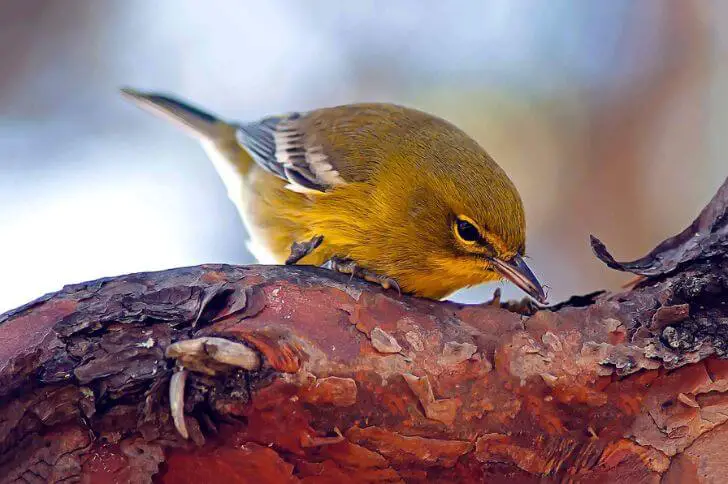
Pine warblers are one of the most popular birds in New York. These small backyard birds are known for their singing.
Identification:
Pine warblers are plump and about 5.5 inches long. Males are olive-yellow and gray with a yellow throat. Females are similar in coloring but duller. Both sexes have long tails.
Interesting facts:
Pine warblers are a type of songbird. They get their name from the fact that they often build their nests in pine trees. They eat insects and berries. They sometimes eat tree sap as well.
27. Prairie Warblers

Prairie warblers are small, colorful songbirds that are found in open habitats across New York. These birds get their name from their breeding habitat, which is typically in grasslands or prairies. Prairie warblers are not currently considered to be at risk of extinction, but their populations have declined in recent years.
Identification:
These little birds are lovely to look at, with bright yellow plumage, dark streaks on their breast and sides. They also have a green back. Males and females look similar, although the males tend to be slightly brighter in coloration.
Other facts:
Prairie warblers eat a variety of insects, including beetles, ants, and grasshoppers. They forage for food by moving nimbly through vegetation, sometimes hanging upside down to reach insects that are hiding underneath leaves.
28. Piping Plover
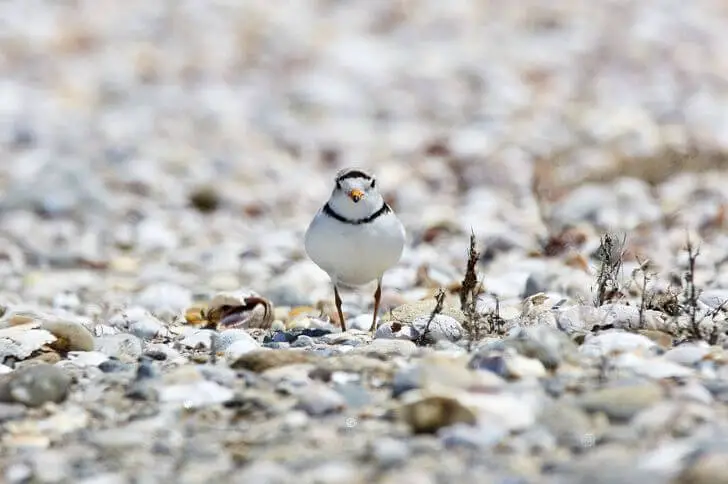
Another group of shorebirds that are resident in Long Island are the piping plovers. These stocky birds are found along the coastline.
Identification:
They are well camouflaged in their breeding plumage, with pale grayish-brown upperparts and white underparts. They also have a black crown stripe and neck band. The birds get their name from their characteristic “piping” call, which is a trill that sounds like “peep.”
Other facts:
Piping plovers typically lay four eggs in a scrape on the ground, which they line with bits of shell and stone. Both parents help to incubate the eggs. The chicks hatch after about 28 days and can fly within 45 days. Piping plovers can live up to 16 years.
29. Red-tailed Hawks

Red-tailed hawks are one of the most common hawk species in New York.
Identification:
The adult red-tailed hawk has a reddish brown back and tail, whitish below with a dark band on their belly. They also have sharp talons and a brown upper. The juvenile red-tailed hawk is similar in appearance to the adult, but with a lighter colored back and tail.
Interesting facts:
Red-tailed hawks can be found in open woodlands, grasslands, and forest edges. The red-tailed hawk is a predator, preying on small mammals such as mice, rabbits, and squirrels. They will also eat reptiles, birds, and insects.
These raptors of Long Island hunt from a perch or while flying low over the ground. When hunting from a perch, the red-tailed hawk will watch for movement below before swooping down to capture its prey.
30. House Finches

House finches are a common sight in many Long Island backyards.
Identification:
These little birds are easily recognized by their reddish brown plumage and their cheerful singing. House finches are members of the Finch family, which includes other well-known birds such as the Purple Finch and the American Goldfinch.
Other facts:
Although they are not endangered, house finches are protected by the Migratory Bird Treaty Act. This act makes it illegal to capture or kill these birds without a permit. House finches were once only found in western North America, but they have now expanded their range to include most of the continent.
These birds typically nest in trees or bushes, but they will also nest in man-made structures such as birdhouses. House finches usually lay between three and six eggs per clutch.
FAQs
Where can I see birds in Long Island?
Places to go bird watching in Long Island include
- Uplands Farm Sanctuary
- Centennial Gardens
- Oyster Bay National Wildlife Refuge
- Mashomack Preserve
- Cold Spring Harbor State Park
- Elizabeth A. Morton National Wildlife Refuge
What birds are native to Long Island?
Northern flickers and American woodcocks.
What long birds live on Long Island?
Large birds of Long Island included ospreys, red-tailed hawks, snow geese, barn owls, and cooper’s hawks.
Are there eagles in Long Island?
Yes, the bald eagle nests in Wertheim National Wildlife Refuge.
Sources:
https://en.wikipedia.org/wiki/Snow_goose
https://www.allaboutbirds.org/guide/Red-winged_Blackbird/overview
Hi fellow bird watcher. Welcome to our small corner of the world. At the spanishbirdguides.com our mission is to share with other bird watchers the things we love about birds, where to go bird watching within the United States, and more. I’d also love to hear from you. Feel free to contact me about your bird watching escapades, share videos, photos and more.
